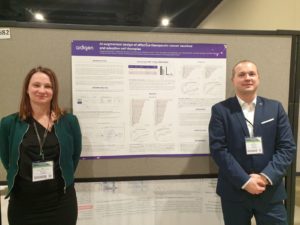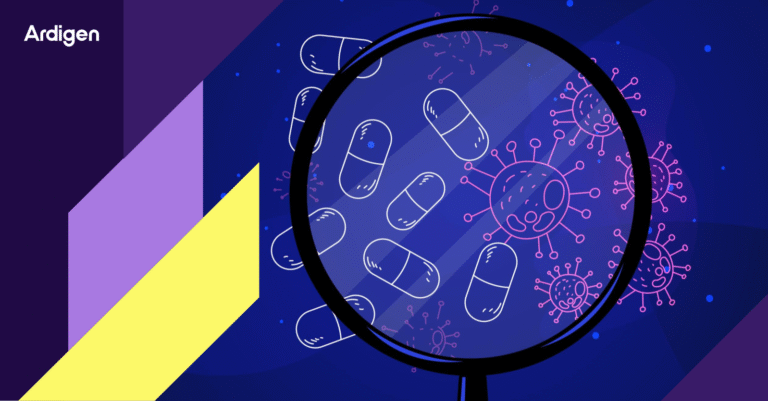The Society for Immunotherapy of Cancer’s (SITC2019) Annual Meeting conference is the leading destination for scientific exchange, education and networking in the cancer immunotherapy field. We are very proud that we have been chosen to present two posters!
1). AI-augmented design of effective therapeutic cancer vaccines and adoptive cell therapies – presented by Piotr Stępniak and Anna Sanecka-Diun

2. Predicting response to anti-PD1 therapy from metagenomic sequencing data with machine learning – presented by Jan Majta –

Read our abstracts:
AI-augmented design of effective therapeutic cancer vaccines and adoptive cell therapies
Authors:
Piotr Stepniak, Giovanni Mazzocco, Alexander Myronov, Iga Niemiec, Katarzyna Gruba, Piotr Skoczylas, Anna Sanecka-Duin, Michał Drwal, Jan Kaczmarczyk,
Background:
The strong involvement of neoantigens-driven CD8+ T-cells is considered a substantial element of immune-mediated tumor rejection. Neoantigens are, in fact, not subject to central immune tolerance and may constitute ideal agents for eliciting tumor-specific immune responses. For these reasons, neoantigens are rapidly gaining interest [1] as central components of personalized cancer vaccines (PCVs), as shown by the number of PCV clinical trials. One of the challenges in the design of PCVs is that only a small fraction of potential neoantigens arising from somatic mutations are immunogenic [2]. Several aspects including highly individual antigenic landscape, restricted number of targetable neoantigens per tumor, complex tumor subclonal structure, private neoantigen-specific T-cell repertoire, presence of inhibitory neoantigens, immune-escape mechanisms, etc. make the prediction of effective neoantigens a particularly challenging task. Standard methods for the selection of neoantigens are typically based on peptide-HLA (pHLA) binding prediction algorithms. Advances in pHLA elution and mass spectroscopy [3] make it possible to identify pHLAs presented on the cell surface, which drives the development of algorithms for the prediction of the natural neoantigen presentation [4, 5]. Combining aspects such as pHLA binding affinity, neoepitope presentation, gene expression, etc. for the prediction of neoepitopes’ immunogenicity is essential for the design of therapeutic cancer vaccines and adoptive cell therapies.
Methods:
We perform a benchmarking study of the available methods for vaccine design. To this end, we carry out a retrospective analysis on selected datasets [2] comprising WES and RNAseq measurements, as well as validation of CD8+ response. We benchmark our approach – ArdImmuneVax – against other available methods.
Results:
For each of the vaccine design tools, we assess the enrichment of immunogenic neoepitopes within the suggested vaccine compositions (e.g., top 20 peptides) using early-enrichment metrics [4]. We analyze the results in an indication-specific fashion in order to assess whether there are significant differences among cancer types. Finally, for each vaccine design method, we assess additional important properties of the resulting target neoepitopes, such as toxicity, tolerance, and peptides’ manufacturability.
Conclusions:
The presented work provides insights into the vaccine design process by quantitatively and qualitatively comparing available tools for the selection of both cancer vaccine composition and targets for adoptive cell therapies.
References
1. Garcia-Garijo A, Fajardo CA, Gros A, Determinants for Neoantigen Identification. Front. Immunol. 2019;10:1392.
2. Parkhurst MR, et al., Unique Neoantigens Arise from Somatic Mutations in Patients with Gastrointestinal Cancers. Cancer Discov. 2019;9:1-14
3. Abelin JG, et al., Mass Spectrometry Profiling of HLA-Associated Peptidomes in Mono-allelic Cells Enables More Accurate Epitope Prediction. Immunity. 2017;46(2):315-326
4. Bulik-Sullivan B, et al., Deep learning using tumor HLA peptide mass spectrometry datasets improves neoantigen identification. Nat. Biotechnol. 2019;37:55-63
5. Zeng H, Gifford DK, DeepLigand: accurate prediction of MHC class I ligands using peptide embedding. Bioinformatics. 2019;35:i278-i283.
Predicting response to anti-PD1 therapy from metagenomic sequencing data with machine learning
Authors:
Jan Majta, Krzysztof Odrzywołek, Agata Szymanek, Monika Majchrzak-Gorecka, Szymon Wojciechowski, Zuzanna Karwowska, Kaja Milanowska
Background:
Recent years have brought the breakthrough to the immune checkpoint therapy (ICT) research with the discovery of the role of gut microbiota (GM) in the treatment response rate. A number of publications describes not only the association, but more importantly the impact of intestinal communities on ICT response [1-3]. The published research points to the specific traits of GM that are associated with its beneficial role. A common approach identified ‘responder gut’ with general metrics of GM like high diversity or richness, which can be associated with non-dysbiotic intestine. Furthermore, each study identified specific clades enriched in responder or non-responder group. Nevertheless, the taxonomic profile of samples is insufficient to build a predictive model of ICT response [4]. Additionally, bacteria identified in a single cohort were not found significant in any other study [5]. It suggests that not the taxonomy, but the function should be a primarily analyzed property in microbiome research. More importantly, the design of microbiota-based treatment requires more specific features than diversity, e.g. a certain strain or function. Therefore, we believe it is essential to develop an algorithm that combines high quality machine learning with interpretable, actionable results.
Methods:
We carried out a classification study to identify responders to anti-PD1 treatment for metastatic melanoma, using shotgun metagenomic sequencing data from three published cohorts. We developed a novel algorithm – BiomeScout – to build cohort-specific feature space and predict therapy outcome for each patient.
Results:
In analyzed cohorts, we detected a function associated signal and used it for R/NR classification. We benchmarked BiomeScout’s performance on the Houston cohort achieving AUC=0.76, outperforming already published results [4]. Moreover, BiomeScout selects a set of functional features along with their sequential representation, ready to be used as a biomarker or a component for Live Biotherapeutic Product (LBP) design.
Conclusions:
Presented work advocates for the importance of function-oriented microbiome research in ICT. Furthermore, BiomeScout’s algorithms enable detection of a cross-cohort signal which is currently in testing phase.
References:
1. Gopalakrishnan V, Spencer CN, Nezi L,Reuben A, Andrews MC, Karpinets TV, et al. Gut microbiome modulates response to anti-PD-1 immunotherapy in melanoma patients. Science.
2018;359: 97–103.
2. Matson V, Fessler J, Bao R, Chongsuwat T, Zha Y, Alegre M-L, et al. The commensal microbiome is associated with anti-PD-1 efficacy in metastatic melanoma patients. Science. 2018;359: 104–108.
3. Routy B, Le Chatelier E, Derosa L, Duong CPM, Alou MT, Daillère R, et al. Gut microbiome influences efficacy of PD-1-based immunotherapy against epithelial tumors. Science. 2018;359: 91–97.
4. Gharaibeh RZ, Jobin C. Microbiota and cancer immunotherapy: in search of microbial signals. Gut. 2019. pp. 385–388. doi:10.1136/gutjnl-2018-317220
5. Trinchieri G. The microbiome in cancer therapy. American Association for Cancer Research Annual Meeting 2019. Mar 29 – Apr 3 Atlanta, GA




